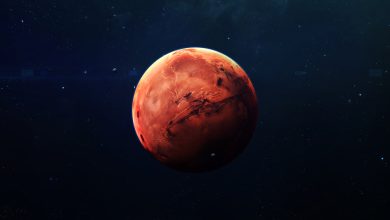Behind the Rings: 10 Little-Known Facts About Saturn

Saturn, the sixth planet from the Sun, has long captured humanity’s imagination and scientific curiosity. Known primarily for its stunning rings, this gas giant holds a myriad of secrets and peculiarities that transcend its most obvious feature.
Beyond the shimmering allure of its rings, Saturn is a world of deep mysteries and lesser-known facts that highlight its unique place in our solar system. In this blog post, we will venture beyond the familiar, exploring facts about Saturn that reveal the true complexity and marvel of this celestial giant.
From its discovery to the composition of its rings, and from its many moons to the peculiar phenomena that occur within its atmosphere, join us as we unwrap the layers behind the rings to discover the lesser-known aspects of one of the most fascinating planets in our cosmic neighborhood.
1. The Discovery of Saturn
While Saturn has been a prominent feature in the night sky observed by ancient civilizations for thousands of years, its official discovery is attributed to the advancements in telescope technology in the early 17th century.
Galileo Galilei is often credited with the first telescopic observation of Saturn in 1610, although he mistakenly believed the planet’s rings to be large moons on either side due to the limitations of his telescope.
It wasn’t until later that year and into the early 1620s that the rings of Saturn were identified as surrounding the planet, thanks to the improved telescope designs of astronomers like Christiaan Huygens.
This marked the beginning of a deeper understanding and fascination with Saturn, leading to the numerous discoveries and studies that continue to this day.
2. The Composition of Saturn’s Rings
The ethereal rings of Saturn, often the centerpiece of its celestial allure, are not the solid disks they might appear to be from afar. Instead, they are composed of countless small particles that range in size from tiny ice crystals to massive boulders.
These particles are primarily made of water ice, with a sprinkling of rock and dust. This icy composition reflects sunlight, giving the rings their brilliant shine when observed from Earth. A common misconception is that Saturn’s rings are a continuous, solid form.
In reality, the rings are comprised of distinct gaps and divisions, such as the Cassini Division, a large gap visible between the two brightest rings.
This nuanced structure, combined with the material composition, contributes to the fascinating complexity of Saturn’s rings, challenging the simplistic notion of a singular, solid ring encircling the planet.
3. Saturn’s Many Moons
One of the most captivating facts about Saturn is its astonishing collection of moons. With over 80 confirmed moons, this planet boasts the second-largest moon family in our Solar System, only trailing behind Jupiter.
Among this celestial cohort, Titan stands out as the crown jewel; it is not only the largest moon of Saturn but also the second-largest in the Solar System, larger than the planet Mercury.
Titan is especially intriguing due to its dense atmosphere and the presence of liquid lakes and seas of hydrocarbons on its surface, a stark contrast to the barren, rocky landscapes typical of other moons.
Another fascinating moon is Enceladus, known for its icy jets that spew water vapor and organic compounds into space, hinting at the potential of an underground ocean.
Then there’s Iapetus, with its unique two-tone coloration, creating a stark difference between its two hemispheres. These moons are just a glimpse into the diverse and dynamic world that orbits Saturn, each with its own mysteries and the potential to unlock secrets about the origins of our Solar System.
4. The Length of a Day on Saturn
The measurement of a day on Saturn presents a unique challenge compared to Earth, primarily due to Saturn’s rapid rotation and the gaseous nature of the planet. A day on Saturn, defined as one full rotation on its axis, lasts about 10.7 hours, making it significantly shorter than a day on Earth, which lasts about 24 hours.
This swift rotation rate results in one of the shortest days in our solar system, creating a stark contrast to the leisurely paced rotations of larger, solid planets.
The rapid rotation also contributes to extreme weather patterns and phenomena within Saturn’s atmosphere, further highlighting the differences between Saturn and our home planet.
This comparison is a vivid reminder of the diversity of planetary behaviors within our solar system, encouraging us to appreciate the unique conditions that make life on Earth possible.
5. The Mystery of Saturn’s Hexagon
One of the most striking and enigmatic features of Saturn is the bizarre hexagon-shaped storm located at its north pole. This six-sided jet stream, larger than two Earths placed side by side, has mystified astronomers since its discovery by the Voyager missions in the early 1980s.
With sides nearly 14,000 km (about 8,700 miles) long, the hexagon circulates at speeds exceeding 300 km/h (about 200 mph), confining a massive, raging storm within its boundaries.
Unlike any weather phenomenon found on Earth, the Saturnian hexagon has remained remarkably stable over decades of observation, maintaining its geometric precision with little variation.
The origins and mechanics of this phenomenon are still under investigation, with theories suggesting that it could be the result of varying atmospheric speeds at different latitudes, combined with Saturn’s rapid rotation.
The enduring mystery of Saturn’s hexagon highlights the planet’s complex atmospheric dynamics and stands as a testament to the continuing surprises our solar system holds.
6. Saturn’s Atmosphere
Saturn’s atmosphere, a swirling tapestry of clouds and winds, is primarily composed of hydrogen and helium, starkly differing from the nitrogen and oxygen-rich envelope that surrounds Earth.
This gaseous composition lends a unique characteristic to Saturn, making it less dense and leading to its classification as a gas giant. Unlike Earth, where a breathable atmosphere and protective ozone layer harbor life, Saturn’s atmosphere features extreme temperatures and pressures, with no solid surface beneath the clouds.
The vivid bands and storms visible on Saturn, including the iconic hexagon at the north pole, further mark the distinctiveness of its atmospheric conditions.
These mesmerizing patterns are driven by rapid wind speeds and the planet’s swift rotation, contrasting with the more temperate and stable climate experienced on Earth.
This comparative look not only underscores the diversity of planetary atmospheres in our solar system but also highlights Earth’s uniqueness in supporting life.
7. The Density Puzzle
A fascinating aspect that adds to the enigma of Saturn is its overall density. Surprisingly, even though Saturn is a gas giant, its density is so low that if one could find a body of water large enough, Saturn would float.
This remarkable fact stems from its composition, dominated by hydrogen and helium, which contributes to a mean density less than that of water.
This comparison showcases not just an interesting trivia piece but underscores the vast differences in planetary composition and structure within our solar system.
The idea of a planet floating in water challenges our conventional perceptions and highlights the incredible diversity and wonder of the celestial bodies that share our cosmic neighborhood.
8. The Sounds of Saturn
Among the many wonders Saturn presents, the eerie sounds recorded by spacecrafts orbiting this distant giant are perhaps the most otherworldly. These sounds, captured primarily by the Cassini spacecraft, offer us a haunting audio glimpse into the complex dynamics of Saturn’s environment.
Far from being mere noise, these recordings are electromagnetic waves converted into audible sounds, revealing the interactions between the solar wind and Saturn’s magnetic field.
These celestial whispers tell tales of charged particles dancing along magnetic lines, of storms raging in the stratosphere, and of the delicate ballet performed by Saturn’s numerous moons.
Each sound provides valuable insights into the hidden processes that drive the planet’s atmosphere and magnetosphere, signifying a profound connection between the vibrations of space and the scientific curiosity that compels us to listen and learn.
Through these sounds, Saturn communicates in a universal language, deepening our understanding of the cosmos and reminding us of the mysteries that lie beyond our Earthly home.
9. Saturn’s Ring Rain
One of the most captivating and lesser-known phenomena associated with Saturn is the so-called “ring rain.” This enthralling occurrence involves icy particles from Saturn’s rings being pulled into the planet’s atmosphere by its gravitational pull, creating an ethereal “rain.” This continuous shower of water and ice particles has profound effects on Saturn’s atmosphere.
It not only alters the chemical composition of the atmosphere by introducing additional water but also plays a crucial role in shaping the atmospheric dynamics.
The infusion of these particles from the rings into the atmosphere contributes to the depletion of the rings themselves, hinting at a complex interplay between Saturn and its iconic rings.
This interaction between the rings and the planet’s atmosphere offers invaluable clues about the evolutionary processes at play, suggesting a far more dynamic relationship than previously understood.
The phenomenon of ring rain, therefore, not only adds to the mystique of Saturn but also highlights the intricate connections that define the celestial bodies within our solar system, inviting further exploration into the secrets they hold.
10. The Exploration Missions
The exploration of Saturn has been a monumental chapter in our quest to understand the vast reaches of our solar system. Since the pioneer Voyager missions in the early 1980s, which first unveiled the intricate beauty of Saturn’s rings and the mysterious hexagon-shaped storm at its north pole, humanity’s fascination with this gas giant has only deepened.
The Cassini-Huygens mission, a collaboration between NASA, the European Space Agency (ESA), and the Italian Space Agency, marked a significant leap forward, orbiting Saturn from 2004 to 2017.
This mission provided an unprecedented close-up of the planet, its complex ring system, and its moons, including Titan, where the Huygens probe made a historic landing.
Through these missions, we’ve gleaned insights into Saturn’s atmospheric conditions, the intriguing “ring rain” phenomenon, and the dynamic interactions between the planet and its moons.
Looking to the future, proposed missions aim to further explore Saturn’s icy moons, particularly Enceladus and Titan, believed to hold subsurface oceans and possibly the conditions necessary for life.
These future missions, still in the conceptual or planning stages, promise to unlock more secrets of Saturn, shedding light on the origins of our solar system and the potential for life beyond Earth.
Conclusion
As we draw the curtain on our cosmic voyage “Behind the Rings: 10 Little-Known Facts About Saturn,” it’s clear that Saturn is not just another planet in our solar system, but a world brimming with mysteries and marvels.
From its atmospheric complexities, showcased by the iconic hexagon storm at its north pole, to the haunting sounds that echo through space, Saturn captivates the imagination and drives home the wonder of the universe beyond our own planet.
The phenomenon of “ring rain” uncovers the dynamic interactions within Saturn’s system, while the density so low that the giant would float if placed in water, challenges our understanding of planetary science.
These revelations, brought closer to us by historic missions like Voyager and Cassini, not only expand our knowledge but encourage a deeper appreciation for the intricate beauty of our solar system.
The exploration of Saturn and its myriad of moons continues to remind us of the boundless curiosity that defines humanity’s spirit of exploration.
As we look ahead to future missions poised to unlock further secrets of Saturn, the promise of uncovering subsurface oceans on moons like Enceladus and Titan hints at the potential for discovering life beyond Earth.
Such endeavors not only push the boundaries of science but also spark a sense of unity and purpose in our quest to understand our place in the cosmos.
In closing, Saturn’s enigmatic presence in our night sky serves as a beacon for astronomers, scientists, and dreamers alike, inviting us to continue our celestial quests.
The wonders of Saturn underscore the importance of continued exploration and support for astronomy. They remind us that, in the vast expanses of our universe, there are always more secrets to uncover, more stories to tell, and more horizons to explore.
May the rings of Saturn inspire you to look up, wonder, and perhaps, dream a little dream of voyaging to the far reaches of our solar system and beyond.
The exploration missions to Saturn have not only deepened our understanding of this majestic planet but have also sparked a global conversation about the mysteries of our solar system.
From the Voyager missions in the 1980s to the groundbreaking Cassini-Huygens mission that concluded in 2017, each step has brought us closer to answering some of the cosmos’ most profound questions.
These missions have unveiled the complexities of Saturn’s atmosphere, the intriguing phenomena of ring rain, and the potential for life-harboring conditions on its moons.
However, the story of Saturn is far from complete. We invite our readers to join in this cosmic dialogue – share your thoughts, any interesting facts you know about Saturn, or questions you might have in the comments below. Your insights and curiosity can light the path for future explorations, as we continue to unravel the secrets of Saturn and beyond.




